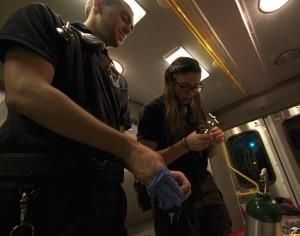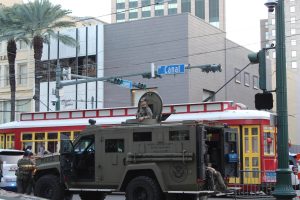No headline provided

March 2, 2012
At 10:30 p.m. Feb. 18, the Saturday of Mardi Gras weekend, the Tulane Emergency Medical Service’s student staff received its first call of the night.
A student was showing signs of a mild allergic reaction in one of the dorms. When I arrived at the scene, the team of three was already at the dorm.
The third rider, Sarah Edwards, checked the patient’s vital signs, including her breathing, pulse and the level of oxygen in her blood. Hannah Gilder, the second rider, asked her questions about her allergies and what she had eaten, while Cody Foster, crew chief and TEMS’ newly-elected director of operations evaluated the patient’s symptoms and consulted a doctor.
Following the doctor’s recommendation, the team decided to transport the patient to a hospital to receive further treatment.
“Sometimes there are things that we can do immediately and sometimes not,” TEMS Director Thomas Gilder said. “A lot of what we do is to provide free emergent transport for people to the hospital for more advanced care.”
Calls about orthopedic injuries, which involve people falling down, breaking bones, or dislocating joints, comprise about 26 percent of all TEMS calls, contrary to what some students might expect.
Alcohol intoxication cases constitute only about 15 percent of all TEMS calls.
“Whenever I hear that somebody got TEMSed, I automatically think it must be someone who had too much to drink,” freshman Tracy Godbe said. “I guess I hear about people being drunk more often than I hear about people breaking their limbs.”
Tracy is not alone in her unfamiliarity with the true nature of TEMS. Many students hold widespread misconceptions about TEMS, including that it only treats dangerously drunk students.
“Weekend nights, we do get patients who are drunk, but overall, it is definitely not as big a proportion of our patient population as people would tend to stereotype it as,” Hannah Gilder said. “Even on Saturday nights, half of my patients are drunk, half of my patients are other things.”
After the team safely transferred the patient to the hospital, they settled in to complete the many forms describing what happened on the call. I listened as the members described the positives and negatives of their performance and listed areas in which they could improve.
Once back at Tulane, the TEMS crew waited for its next call. They spent most of their 12-hour shift waiting, using their downtime for sleeping, doing homework, late-night snacking at the Rat and bonding with their fellow TEMS members.
“The best part of the experience is just the friends that I’ve made through TEMS,” Foster said. “It’s fun going on calls since that’s what we’re all about, but it’s everything outside of our professional role that makes TEMS so great.”
The next call came at 2:35 a.m. Feb. 19 from a student who had broken her toe. The team came onto the scene within minutes, wrapped the student’s toe, and gave her ice. In no more than 15 minutes the team was finished and on their way to the ambulance to complete the necessary paperwork.
Because TEMS is centered on campus, it can reach students much sooner than New Orleans Emergency Medical Services can. The average response time for a TEMS call is about five minutes.
“I’ve had patients who weren’t breathing when I came onto the scene,” Tom Gilder said. “New Orleans EMS might have been 15 minutes away, and not breathing for those 15 minutes could have been the difference between life and death for them.”









Leave a Comment